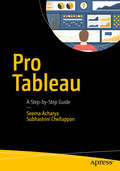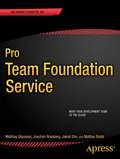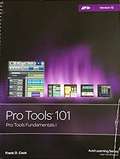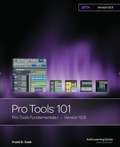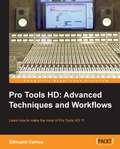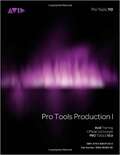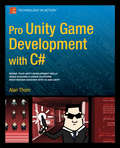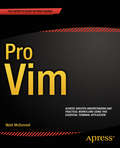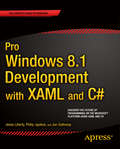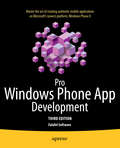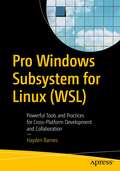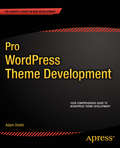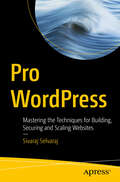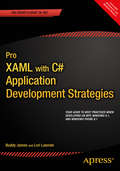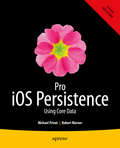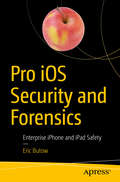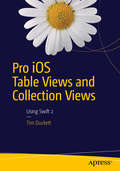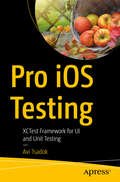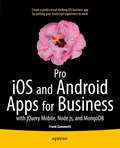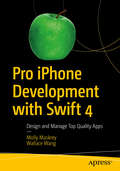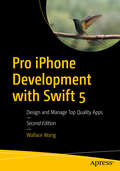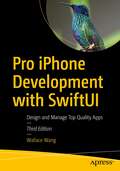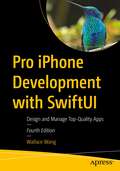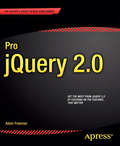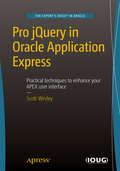- Table View
- List View
Pro Tableau
by Seema Acharya Subhashini ChellappanLeverage the power of visualization in business intelligence and data science to make quicker and better decisions. Use statistics and data mining to make compelling and interactive dashboards. This book will help those familiar with Tableau software chart their journey to being a visualization expert. Pro Tableau demonstrates the power of visual analytics and teaches you how to: Connect to various data sources such as spreadsheets, text files, relational databases (Microsoft SQL Server, MySQL, etc. ), non-relational databases (NoSQL such as MongoDB, Cassandra), R data files, etc. Write your own custom SQL, etc. Perform statistical analysis in Tableau using R Use a multitude of charts (pie, bar, stacked bar, line, scatter plots, dual axis, histograms, heat maps, tree maps, highlight tables, box and whisker, etc. ) What you'll learn Connect to various data sources such as relational databases (Microsoft SQL Server, MySQL), non-relational databases (NoSQL such as MongoDB, Cassandra), write your own custom SQL, join and blend data sources, etc. Leverage table calculations (moving average, year over year growth, LOD (Level of Detail), etc. Integrate Tableau with R Tell a compelling story with data by creating highly interactive dashboards Who this book is for All levels of IT professionals, from executives responsible for determining IT strategies to systems administrators, to data analysts, to decision makers responsible for driving strategic initiatives, etc. The book will help those familiar with Tableau software chart their journey to a visualization expert.
Pro Team Foundation Service
by Jakob Ehn Joachim Rossberg Mathias Olausson Mattias SköldPro Team Foundation Service gives you a jump-start into Microsoft's cloud-based Application Lifecycle Management platform, taking you through the different stages of software development. Every project needs to plan, develop, test and release software and with agile practices often at a higher pace than ever before. Microsoft's Team Foundation Service is a cloud-based platform that gives you tools for agile planning and work tracking. It has a code repository that can be used not only from Visual Studio but from Java platforms and Mac OS X. The testing tools allow testers to start testing at the same time as developers start developing. The book also covers how to set up automated practices such as build, deploy and test workflows. This book: Takes you through the major stages in a software development project. Gives practical development guidance for the whole team. Enables you to quickly get started with modern development practices. With Microsoft Team Foundation Service comes a collaboration platform that gives you and your team the tools to better perform your tasks in a fully integrated way. What you'll learn What ALM is and what it can do for you. Leverage a cloud-based ALM platform for quick improvements in your development process. Improve your agile development process using integrated tools and practices. Develop automated build, deployment and testing processes. Integrate different development tools with one collaboration platform. Get started with ALM best-practices first time round. Who this book is for Pro Team Foundation Service is for any development team that wants to take their development practices to the next level. Microsoft Team Foundation Service is an excellent platform for managing the entire application development lifecycle and being a cloud-based offering it is very easy to get started. Pro Team Foundation Service is a great guide for anyone in a team who wants to get started with the service and wants to get expert guidance to do it right. Table of Contents Introduction to Application Lifecycle Management Introduction to Agile Planning, Development, and Testing Deciding on a Hosted Service Getting Started Working with the Initial Product Backlog Managing Team and Alerts Initial Sprint Planning Running the Sprint Kanban Engaging the Customer Choosing Source Control Options Working with Team Foundation Version Control in Visual Studio Working with Git in Visual Studio Working in Heterogeneous Environments Configuring Build Services Working with Builds Customizing Builds Continuous Deployment Agile Testing Test Management Lab Management
Pro Tools 101: For Pro Tools 12 Software
by Frank D. CookCongratulations on beginning work under Avid's official training program. This book represents the first step on a journey toward mastery of your Pro Tools system. The information, exercises, and projects you will find here apply to all Pro Tools 12 systems.
Pro Tools Fundamentals I: For Pro Tools 12.8 Software (Pro Tools 101)
by Frank D. CookBackground Information; Getting Started with Pro Tools; Pro Tools Basic Controls; Creating Your First Session; Making Your First Audio Recording; Importing and Working with Media; Making Your First MIDI Recording; Selecting and Navigating; Editing Your Media; Mixing and Creating a Bounce; Project 1: Music Session; Project 2: Post Session.
Pro Tools HD: Advanced Techniques and Workflows
by Edouard CamouAn easy-to-follow guide for using Pro Tools HD 11 effectively.This book is ideal for anyone who already uses ProTools and wants to learn more, or is new to Pro Tools HD and wants to use it effectively in their own audio workstations.
Pro Tools Production I for Pro Tools 10.0
by Avid DigidesignPro Tools 110, Official Courseware, Pro Tools Production I
Pro Unity Game Development with C#
by Alan ThornIn Pro Unity Game Development with C#, Alan Thorn, author of Learn Unity for 2D Game Development and experienced game developer, takes you through the complete C# workflow for developing a cross-platform first person shooter in Unity. C# is the most popular programming language for experienced Unity developers, helping them get the most out of what Unity offers. If you're already using C# with Unity and you want to take the next step in becoming an experienced, professional-level game developer, this is the book you need. Whether you are a student, an indie developer, or a season game dev professional, you'll find helpful C# examples of how to build intelligent enemies, create event systems and GUIs, develop save-game states, and lots more. You'll understand and apply powerful programming concepts such as singleton classes, component based design, resolution independence, delegates, and event driven programming. By the end of the book, you will have a complete first person shooter game up and running with Unity. Plus you'll be equipped with the know-how and techniques needed to deploy your own professional-grade C# games. If you already know a bit of C# and you want to improve your Unity skills, this is just the right book for you. What you'll learnHow to plan your game in terms of C# and classes How to import assets from Blender and Maya, including C# automation processes How to handle events and notifications using a C# event notification system How to create intelligent enemies and collectible weapons How to build a cross-platform controller as well as how to write platform-specific code How to develop a resolution-independent graphical user interfaceWho this book is for If you already know a bit of C# and you want to improve your Unity skills, this isjust the right book for you. Unity developers looking to improve their C# workflow and effectiveness, including game development students and professionals, indie developers, artists, designers, and those employed at game development studios. Table of Contents1. Outlining the Game Structurein Terms of C# 2. Optimizing Import Workflows and Import Settings 3: The Game Loop and Developiong a Custom Event-Handling System 4. Building a Cross-Platform Controller 5. Enemies, NPCs, and Artificial Intelligence 6. Custom Weapons: Targeting, Feedback, and More 7. Modifying Game Behavior with Power-ups and Collections 8. The Graphical User Interface and Resolution Independence 9. Persistent Data and Save Game States 10. Final Touches: Polishing and Play-testing"
Pro Vim
by Mark McdonnellPro Vim teaches you the real-world workflows, tips, and tricks of this powerful, terminal-based text editor. This book covers all the essentials, as well as lesser-known but equally powerful features that will ensure you become a top-level performant and professional user, able to jump between multiple sessions while manipulating and controlling with ease many different documents and programming files. With easy-to-digest chapters on all the areas you need to learn, this book is a key addition to your library that will enable you to become a fast, efficient user of Vim. Using this book, you will learn how to properly configure your terminal environment and work without even touching the mouse. You will become an expert in how Vim actually works: how buffers and sessions work, automation through Macros and shell scripting, real-world workflows, and how to work efficiently and fast with plugins and different themes. You will also learn practical, real-world tips on how to best utilize Vim alongside the terminal multiplexer tmux; helping you to manage files across multiple servers and terminal sessions. Avoid common pitfalls and work with best practice ways to efficiently edit and control your files and sessions from the terminal interface. Vim is an advanced power tool that is commonly recognized as being difficult to learn, even for experienced developers. This book shows you how to become an expert by focusing on not only the fundamentals of how Vim works, but also by distilling the author's own experiences learning Vim into an easy-to-understand and follow guide. It's time to bring your programming, editing, and workflow skills up to the professional level - use Pro Vim today. What you'll learn * Understand the fundamentals of how Vim works so you can better utilize its features. * Extend Vim using plugins; along with specific plugins that cover a wide range of technical requirements. * Automate Vim and tmux via the use of Macros and Scripting. * Learn how to make complex pattern based changes across multiple Vim buffers at once. * Pair program with remote users connecting to a single local tmux session. * Learn real-world workflows that integrate both Vim and tmux together. Who this book is for Pro Vim is for any developer who wishes (or has tried in the past and failed) to understand how to leverage the tools provided by Vim and tmux and integrate them into their professional working environment. Allowing them to take advantage of the power features these applications provide to become a better programmer. Table of Contents 1. Introduction 2. Installation and Configuration 3. Fundamentals 4. Files 5. Commands 6. Registers 7. Folding 8. Visual Block Mode 9. Bulk Command Processing 10. Editing Workflow 11. Search and Replace 12. Buffer/Window/Tab Management 13. Automation 14. Lists 15. Marks 16. Sessions 17. Plugins 18. Diffing 19. Custom Commands and Bindings 20. Terminal integration 21. Working with code 22. Practical Tips and Tricks 23. Terminal Multiplexer 24. Fundamentals 25. Modifications 26. Copy and Paste 27. Scripting and Automation 28. Pane/Window Management 29. Pair Programming 30. Workflow Management
Pro Windows 8.1 Development with XAML and C#
by Jesse Liberty Jon Galloway Philip JapikseWindows 8. 1 apps are revolutionizing development on the Windows platform. Fast, fluid, tactile and chrome-free, they provide a brand-new look and feel for Windows users. These apps rely on Microsoft's Windows 8 modern UI to provide their rich and engaging user experiences for both desktop and tablet users. The new UI in turn relies upon the Windows Runtime (WinRT) to give its apps unparalleled flexibility and power. Understanding this stack of new technologies and how they tie in to the proven C# language and the XAML standard is the subject of this book. Experienced writers Jesse Liberty, Phil Japikse, and Jon Galloway explain how you can get the most from Windows 8. 1 by focusing on the features that you need for your project and bringing your existing C# coding knowledge to bear. They begin with a nuts-and-bolts examination of how the technologies fit together and show you everything you need to get up and running with the new platform. Once you have a good understanding on the basics, you progress to more advanced topics steadily increasing your understanding as a whole. This holistic knowledge is essential to truly master Windows 8. 1 development. Each topic is covered clearly and concisely and is packed with the details you need to code effectively. The most important features are given a no-nonsense, in-depth treatment and chapters contain examples that demonstrate both the power and the subtlety of Windows 8. 1. What you'll learnWhat Metro and WinRT are capable of and why they are special Ways to use advanced features to create immersive and engaging Windows 8. 1 applications How to create applications that work seamlessly on tablets and desktops How to prepare and deploy your Windows 8. 1 applications Who this book is for This book is suitable for anyone wanting to get to grips with Windows 8. 1 development using the cross-platform standards of XAML and C#. Table of Contents1 Getting Started 2 Building Your First Windows 8 App 3 Themes, Panels, and Controls4 Binding5 Views6 Local Data7 Remote Data and Services8 Search and Share Contracts9 Notifications10 Application Life Cycle11 Making Money12 Publishing Your App"
Pro Windows Phone App Development
by Falafel SoftwareThe Windows Phone 8 platform provides a remarkable opportunity for Windows developers to create state-of-the-art mobile applications using their existing skills and a familiar toolset. Pro Windows Phone App Development, Third Edition, helps you unlock the potential of this platform and create dazzling, visually rich, and highly functional applications for the Windows Phone Store and bring you up to speed on the new features the Windows Phone 8 API provides. For developers new to the Windows Phone platform--whether with . NET, iOS, or Android experience--this book starts by introducing the requirements, specifications, and basics of Windows Phone development, and then leads you through the complete application development process, using an array of complementary technologies and Microsoft's modern-style app design. Along the way, you'll learn how to Use Microsoft technologies like XAML, . NET, Visual Studio 2012, and Expression Blend effectively to develop modern-style Windows Phone apps Take advantage of the device's sensors with the location service, accelerometer, and touch Make your apps location-aware using GPS data Develop rich media applications that harness the graphics capabilities of Windows Phone models Design and develop Windows Phone applications using the Model-View-ViewModel architecture Publish and sell your application through the Windows Phone Store Whether you're a Microsoft developer, an iOS or Android developer, or someone with prior Windows Phone experience, Pro Windows Phone App Development, Third Edition, is an ideal guide for mastering the Windows Phone 8 platform and compelling Windows Phone app development. What you'll learn How to use Microsoft technologies like XAML, . NET, Visual Studio 2012, and Expression Blend effectively to develop modern-style Windows Phone apps Techniques for taking advantage of the device's sensors with the location service, accelerometer, and touch How to make your apps location-aware using GPS data How to develop rich media applications that harness the graphics capabilities of Windows Phone models The way to design and develop Windows Phone applications using the Model-View-ViewModel architecture The process for publishing and selling your application through the Windows Phone Store Who this book is for If you're a Microsoft developer, this book is primarily for you--you're eager to learn how to use your existing skills to develop for the new Windows Phone platform. If you're an iOS or Android developer, this is an ideal guide for you to learn how to expand the market for your existing applications. This does assume some knowledge of C#, managed code in general, and a basic level of familiarity with Visual Studio. And if you're a proficient Windows Phone developer, get up to speed quickly with the new API endpoints and HTML5 browser support in the Tango update. Software developers proficient in other languages will also find this book helpful to get up to speed with developing Windows Phone applications. Table of Contents Introduction Getting Started WinRT and XAML Phone Controls Navigation Application Life Cycling Gestures Device Support Mapping Live Tiles & Notifications Data Sources Using Data in the Cloud Designing in Expression Blend Marketing Your Applications
Pro Windows Subsystem for Linux (WSL): Powerful Tools and Practices for Cross-Platform Development and Collaboration
by Hayden BarnesThis book covers everything a developer needs to know to hit the ground running and get the most out of Windows Subsystem for Linux (WSL). Since its release, Windows Subsystem for Linux (WSL) has been growing in popularity, moving from curious early adopters to wide-scale interest, including enterprise development teams using WSL in production. This authoritative guide to WSL covers the gamut, introducing developers to WSL architecture, installation and configuration, the WSL command line, all the way to advanced use cases and performance tunings. Practical examples are sprinkled throughout to reinforce understanding. This book is designed to efficiently and effectively get developers comfortable using this highly useful platform for open-source development on Windows. WSL is uniquely suited to cloud and cross-platform development, and system administrator workflows on Windows. Windows developers will begin with the basics of installation and then be introduced to the vast library of open source tools that they can integrate into their own workflows, using their existing development tools, such as Code, Visual Studio, and JetBrains IDEs. Readers will learn, hands on, about using WSL to develop cross-platform and cloud-native applications, work with containers, and deploy a local Kubernetes cluster on WSL. “Much of what WSL is, is what developers make of it” is expert Barnes’ guiding mantra, a theme that is reinforced throughout this valuable cross-platform learning journey. Developers will get excited about the many new opportunities at their fingertips and be astounded at what they can do and achieve with WSL. What You Will Learn Install and configure WSL, a unique and novel configuration processReceive an unbiased overview of WSL, its architecture, installation, the command line, practical use cases, and advanced configurationCreate a development workstation using WSLCompare and contrast the differences between WSL 1 and WSL 2Explore, in depth, some of the more popular workflows in WSL, including Docker containersConsider and plan key factors for a large scale enterprise deployment of WSL Who This Book Is ForDevelopers who need to know WSL and how to build a development stack, integrating it with their preferred code editor or IDE if they so choose; existing Windows and Linux system administrators who want to learn how to install, deploy, and manage WSL; power users who are comfortable in a command line, but may be new to Linux or WSL
Pro WordPress Theme Development
by Adam OnishiPro WordPress Theme Development is your comprehensive guide to creating advanced WordPress themes. Designed for for professional web designers and developers who are comfortable with PHP and WordPress, this book teaches you every aspect of professional theme development. You will learn how to build themes from scratch, how to monetize the themes you create, and how to capitalize on this by creating advanced themes for your clients or selling premium themes. This book builds on your current knowledge of PHP and web development to create a WordPress theme from scratch. It uses a real-world theme example that you can build, to demonstrate each feature in a practical way. It shows you how to take control of WordPress with custom posts types and taxonomies, and covers anatomy and hierarchy, use of the loop, hooks, short codes, plug-ins and much more. WordPress is one of the most successful open-source blogging and content management systems available, and theme development has become a major part of the WordPress ecosystem. Start working with WordPress themes like a pro today with Pro WordPress Theme Development. What you'll learn How to create a WordPress theme from scratch How to use the WordPress system to your advantage to create amazing advanced functionality How to earn money through selling your custom themes How to take control of WordPress as a content management system with custom posts types and taxonomies How you should secure your WordPress theme to give peace of mind to your user Who this book is for Pro WordPress Theme Development is for web designers and developers who want to start creating their own themes and get the most out of them. This book is for web professionals who are familiar with PHP and WordPress, and have used both before, but want to go from editing themes to creating their own custom themes. Pro WordPress Theme Development is perfect for developers who want to create themes from scratch with advanced features, capitalize on the large WordPress community, and monetize their new found skills. Table of Contents Getting Started Theme Anatomy and Template Hierarchy Content Options and The Loop Using Custom Post Types Creating Custom Taxonomies and Fields Customize with Hooks and Short Codes Theme Options Users, Roles, and Permissions Plugins - When The Time is Right Security and Performance Distributing Your WordPress Theme Extending your WordPress Theme Plugin Development WordPress Multisite
Pro WordPress: Mastering the Techniques for Building, Securing and Scaling Websites
by Sivaraj SelvarajPro WordPress is your ultimate guide to unlocking the full potential of the world's leading content management system. From novice bloggers to seasoned developers, this comprehensive resource offers a step-by-step journey through every aspect of WordPress customization, security and performance optimization. With clear explanations and practical examples, you'll learn how to set up your WordPress environment, choose the right themes and plugins, and customize your site with advanced techniques such as custom post types, widgets, shortcodes, and more. Dive deep into the world of WordPress security and discover how to safeguard your website against cyber threats with strategies like two-factor authentication, secure file permissions, and regular security audits. But that's not all – this book also equips you with the tools and knowledge to optimize your site for lightning-fast performance and high search engine rankings. Learn how to leverage caching mechanisms, minimize HTTP requests, and implement SEO strategies to boost your site's speed and visibility. Whether you're managing a single WordPress site or overseeing a multisite network, you'll find invaluable insights and best practices for scalability and high availability. Real-world case studies provide inspiration and guidance, showcasing successful WordPress implementations and effective strategies for growth. Whether you're a business owner, freelancer, or aspiring web developer, Pro WordPress empowers you to take control of your online presence and build websites that stand out in today's competitive digital landscape. Unlock the full potential of WordPress and elevate your web development skills with this essential resource. You Will Learn: The WordPress ecosystem in its entirety, including its history, core features, and community dynamics. Develop expertise in customizing WordPress themes and plugins using CSS, PHP, and advanced techniques like custom post types and widgets Implement robust security measures to protect your WordPress site from common vulnerabilities, such as brute force attacks and malicious code injections Optimize your website's performance through caching mechanisms, image optimization, and other techniques to enhance user experience and SEO rankings More advanced topics such as managing multisite networks, scalability and high availability to effectively scale your WordPress projects and handle high traffic volumes Who is it for: Web designers and developers to business owners looking to develop a webiste of their own as well as bloggers and hobbyists who are looking to design, launch and maintain a website whatever the project.
Pro XAML with C#
by Buddy James Lori LalondePro XAML with C#: Application Development Strategies is your guide to real-world development practices on Microsoft's XAML-based platforms, with examples in WPF, Windows 8. 1, and Windows Phone 8. 1. Learn how to properly plan and architect an application on one or more of these platforms for a robust, scalable solution. In Part I, authors Buddy James and Lori Lalonde introduce you to XAML and reveal proven techniques for developing successful line-of-business applications. You'll also find out about some of the conflicting needs and interests that you might encounter as an enterprise XAML developer. Part II begins to lay the groundwork to help you properly architect your application, providing you with a deeper understanding of domain-driven design and the Model-View-ViewModel design pattern. You will also learn about proper exception handling and logging techniques, and how to cover your code with unit tests to reduce bugs and validate your design. Part III explores implementation and deployment details for each of Microsoft's XAML UIs, along with advice on deploying and maintaining your application across different devices using version control repositories and continuous integration. Pro XAML with C# Application Development Strategies is for intermediate to experienced developers looking to improve their professional practice. Readers should have experience working with C# and at least one XAML-based technology (WPF, Silverlight, Windows Store, or Windows Phone). What you'll learn Analyze a business problem and develop a solution within the sometimes conflicting interests of a real business team Use domain driven design to get maximum business value from your development efforts Develop applications in Visual Studio making best use of its integrated design and development views Implement the popular MVVM design pattern to decouple your user interface from your core domain logic Cover your code with unit tests to reduce bugs and validate your design Deploy and maintain your application across different devices Who this book is for Pro XAML with C#: Application Development Strategies is for intermediate to experienced . NET developers. Readers should have experience working with C# and at least one XAML-based technology (WPF, Silverlight, Windows Store or Windows Phone). Table of Contents Part I: Getting Started Chapter 1: What Is XAML? Chapter 2: Software Craftsmanship Part II: Laying The Groundwork Chapter 3: Domain-Driven Design Chapter 4: Design Patterns Chapter 5: Unit Testing Chapter 6: Advanced Unit Testing and Test-Driven Development Chapter 7: Exception Handling and Logging Part III: Completing the User Interface Layer Chapter 8: The WPF User Interface Chapter 9: The Windows Phone User Interface Chapter 10: The Windows User Interface Chapter 11: Deploying and Maintaining Your Application
Pro iOS Persistence
by Michael Privat Robert WarnerPro iOS Persistence explains how to build apps in Objective-C and Swift that persist and use data most effectively including the popular Core Data framework. Covering common and advanced persistence patterns, this book prepares any iOS developer to store and retrieve data accurately and efficiently. This book starts by giving you a solid grounding in Core Data, providing a foundation for the rest of the book. With this knowledge, you'll have all you need to master Core Data and power your data-driven applications. You'll see how to work with SQLite and how to create an efficient data model to represent your data. Once you've established your data model, you'll learn how to work with data objects and refine result sets to get the most out of the stored data. The advanced portions of the book begin by showing you how to tune your apps' performance and memory usage, to give you a truly professional edge. You'll see how to version and migrate your data as well, to ensure your data stays organized and efficient. Finally, the book covers managing table views with NSFetchedResultsController.
Pro iOS Security and Forensics: Enterprise Iphone And Ipad Safety
by Eric ButowExamine how to keep iOS devices safe in the physical world, including creating company policies for iPhones; assessing and defending against cyber vulnerabilities and attacks; working with preinstalled as well as third party tools; and strategies for keeping your data safe including backing up and screen locks.Managing and maintaining iPhones and iPads in a corporate or other business environment inherently requires strict attention to security concerns. Managers and IT professionals need to know how to create and communicate business policies for using iOS devices in the workplace, and implement security and forensics tools to manage and protect them.The iPhone and iPad are both widely used across businesses from Fortune 500 companies down to garage start-ups. All of these devices must have secure and monitorable ways to connect to the internet, store and transmit data without leaks, and even be managed in the event of a physical theft. Pro iOS Security and Forensics covers all these concerns as well as also offering tips for communicating with employees about the policies your business puts in place, why those policies are important, and how to follow them.What You'll LearnReview communicating policies and requirements for use of iPhones Keep your iPhone safe in the physical world Connect to the Internet securely Explore strategies for keeping your data safe including backing up and screen locksWho This Book Is ForManagers and IT professionals working in a business environment with iPhones and iPads.
Pro iOS Table Views and Collection Views
by Tim DuckettPro iOS Table and Collection Views with Swift takes a task-oriented focus to assist you when implementing customized table views or collection views. It's a great reference and customization cookbook at the same time, useful for beginners as well as intermediate developers. You'll learn how to create table and collection views for a variety of screen types, including the new Watch, using the Swift 2 programming language. But this book doesn't leave the Objective-C programmer behind -- you'll also find code samples for Objective-C. If you're an iOS app developer, chances are you'll be using table views and now collection views in your development projects. Table views are the bread and butter of iOS apps. With them, you can create everything from the simplest of lists to fully tricked-out user interfaces, and the possibilities are even greater now with Watch glances and a larger variety of screen sizes. Table views and collection views are some of the most complex components found in UIKit. While using them for boring standard user interfaces is quite simple, customizing them can become really challenging. Covers the entire Table View and Collection View APIs in depth Covers customization and performance topics in depth Task-oriented reference with multiple levels of detail What you'll learn The anatomy of tables and cells The design patterns that powers table views and collection views How to create and configure table views and collection views How to customize every last little detail of the view Advanced tips and tricks for performance and killer user interfaces The latest updates in iOS 9 and how to exploit them Who this book is for The book is for iOS developers who need to customize table views and collection views. The information is divided into several layers of detail. While the book covers complex customization topics and user interaction techniques, it provides the fundamental basics needed for customization. Both beginners and intermediate developers will find great value in this book as a helpful reference, at hand to quickly refresh their knowledge at any given time. Table of Contents Chapter 1: Table Views Quick Start Chapter 2: How the Table View Fits Together Chapter 3: Collection Views Quick Start Chapter 4: How the Collection View fits together Chapter 5: Feeding Data to your Views Chapter 6: How the Table View Cell Fits Together Chapter 7: Improving the Look of Cells Chapter 8: Creating Custom Cells with Subclasses Chapter 9: Improving Interaction Chapter 10: Using Tables for Navigation Chapter 11: Indexing, Grouping, and Sorting in Tables Chapter 12: Selecting and Editing Content Chapter 13: Static Tables Chapter 14: Tables in WatchKit Chapter 15: Collection View Flow Layouts Chapter 16: Collection View Custom Layouts Chapter 17: Animated and Interactive Collection Views
Pro iOS Testing: XCTest Framework for UI and Unit Testing
by Avi TsadokDiscover what tools there are for unit testing in iOS, and how to work in a test-driven environment. This book reveals how testing is a crucial capability in any iOS developer’s toolset, and a minimum requirement in iOS interviews.A few years ago, tests on mobile platforms were not very popular. It wasn’t a technical constraint, more a cultural one. But these days it’s a crucial skill set, especially when projects become big and hard to maintain. This book shows you how to set up a testing target in XCode unit tests. You'll learn how to write unit tests properly and incorporate concepts like spies and mocks and code coverage. You'll also learn the philosophy behind the architecture of UI tests, and how to mock network and DB layers in testing. Write unbreakable UI tests performance tests, as well. And learn the difference between integration tests and snapshot testing.This book will show you how to maintain code that's not only bug-free but will also remain high quality over time and maintainable while you make changes and refactors during an app's life. Testing in all its aspects is the best way of maintaining iOS projects to run fast and reliably long after you've released them. Many iOS developers working today lack an understanding of the advantages of testing, and might be unfamiliar with tools that make the job easier, such as XCTest framework. With Pro iOS Testing you'll see how to develop and test apps that work and stay working for a long time. What You'll LearnSet up a stable testing systemExtend an app's lifetime with testing before releaseIncorporate testing into your everyday development routineWrite unbreakable UI tests performance testsUnderstand the difference between integration tests and snapshot testingWho This Book Is ForProfessional iOS developers with extensive experience in the basics of building apps.
Pro iOS and Android Apps for Business
by Frank ZammettiWith Pro iOS and Android Apps for Business, you can take your web development experience and apply it toward creating a full-featured business app, from soup to nuts. Frank Zammetti shows you how to create a client app using jQuery Mobile wrapped in PhoneGap, and how to create a node. js-based server that uses MongoDB as its data store. You never have to deal with learning Objective-C, Java or any other difficult-to-learn language. Instead, you can build on your existing HTML5, JavaScript and CSS experience to quickly and effectively build any app your business needs. You can apply this knowledge to iOS andAndroid apps as well as other mobile platforms since the technologies used support most modern mobile platforms as well. You'll learn: How to design a full-featured app, including requirements like offline access How to build the client-side of the app using jQuery Mobile, including adding stub code for calling the node. js server How to create a simple server with node. js and interact with it using REST How to use MongoDB with node. js for data storage How to use PhoneGap to ready your app for mobile deployment How to test and debug your app on iOS and Android Pro iOS and Android Apps for Business is for experienced web developers who need to get up to speed quickly in building iOS and Android apps for business. Are you ready to join the mobile revolution using the same technologies you already use to build great web applications? If so, this is the book for you "
Pro iPhone Development with Swift 4: Design and Manage Top Quality Apps
by Wallace Wang Molly MaskreyAcquire and master the information required to take you to the next level beyond basic iPhone development using Swift. In this follow up work to the best selling Beginning iPhone Development with Swift, you’ll learn how to improve your apps by managing the performance of your programs using parallelization, getting data in and out of the cloud, using gestures, the camera, 3D touch, sensors as well as newer features having debuted this year.In its fourth edition, Pro iPhone Development with Swift 4 covers the additional information you want to know to extend your apps into the next level.What You Will LearnAdd parallel functionality using Grand Central DispatchUse the camera and access photosUse SiriKitWho This Book is ForAspiring iOS app developers familiar with the Apple Swift programming language and/or the iOS SDK, but ready to move to the next level.
Pro iPhone Development with Swift 5: Design and Manage Top Quality Apps
by Wallace WangIf you’ve already learned the basics of Swift and iOS programming, it’s time to take your skills to the next level. In this follow up work to the best-selling Beginning iPhone Development with Swift, you’ll learn tips for organizing and debugging Swift code, using multi-threaded programming with Grand Central Dispatch, passing data between view controllers, and designing apps for multiple languages. You’ll also see how to play audio and video files, access the camera and save pictures to the Photos library, use location services to pinpoint your position on a map, display web pages, and create animation to spice up any user interface. Finally, you’ll learn how to use Apple’s advanced frameworks for machine learning, facial and text recognition, and creating augmented reality apps. Pro iPhone Development with Swift 5 provides insightful instruction on how to improve your existing apps or create powerful new iOS apps using the latest version of the Swift programming language. What You Will LearnSave and retrieve data when apps close or get pushed in the backgroundRecognize speech with Apple’s advanced frameworks Create augmented reality appsUnderstand spoken commands with SiriWho This Book is ForAspiring iOS app developers familiar with the Apple Swift programming language and/or the iOS SDK, but ready to move to the next level.
Pro iPhone Development with SwiftUI: Design and Manage Top Quality Apps
by Wallace WangYou know the basics. Your Swift code flows with logic and ease. This isn't your first time building a workable app for iOS platforms. Now, it's time to build a magical app for iOS platforms! Move beyond what you mastered in the best-selling Beginning iPhone Development with SwiftUI. Debug Swift code, use multi-threaded programming with Grand Central Dispatch, pass data between view controllers, and design apps functional in multiple languages. Not only will your apps run like magic under the hood but, with the new standard of SwiftUI, you'll add animations, scaling, multiscreen support, and so much more to your interfaces. You’ll also see how to integrate audio and video files in your apps, access the camera and send pictures to and from the Photos library, use location services to pinpoint your user's position on a map, and display web pages in-app. Don't just stop at flawless code and stickily engaging interfaces. Give your apps a mind with Apple’s advanced frameworks for machine learning, facial and text recognition, and augmented reality. Pro iPhone Development with SwiftUI enlightens you to the world of rich design, solid code, and thoughtful processing needed to make apps that wow. Integrate all these extraordinary iOS features and embrace the world of possibilities in the Swift programming language with SwiftUI. What You Will LearnSave and retrieve data when apps close or get pushed in the backgroundRecognize speech with Apple’s advanced frameworks Create augmented reality appsUnderstand spoken commands with SiriWho This Book is ForAspiring iOS app developers familiar with the Apple Swift programming language and/or the iOS SDK, but ready to move to the next level.
Pro iPhone Development with SwiftUI: Design and Manage Top-Quality Apps
by Wallace WangYou know the basics. Your Swift code flows with logic and ease. This isn't your first time building a workable app for iOS platforms. Now, it's time to build a magical app for iOS platforms! Move beyond what you mastered in the best-selling Beginning iPhone Development with SwiftUI. This revised and expanded Fourth Edition enlightens you to the world of rich design, solid code, and thoughtful processing needed to make apps that wow. Integrate all these extraordinary iOS features and embrace the world of possibilities in the Swift programming language with SwiftUI. New chapters cover customizing grids, using ViewThatFits, adding search and share links, using SpriteKit, and Developing Tests. Not only will your apps run like magic under the hood but with the new standard of SwiftUI, you'll add animations, scaling, multiscreen support, and so much more to your interfaces. Debug Swift code, use multi-threaded programming with Grand Central Dispatch, pass data between view controllers, and design apps functional in multiple languages. You’ll also see how to integrate audio and video files in your apps, access the camera and send pictures to and from the Photos library, use location services to pinpoint your user's position on a map, and display web pages in-app. Don't just stop at flawless code and stickily engaging interfaces. Pro iPhone Development with SwiftUI explains how to give your apps a mind with Apple’s advanced frameworks for machine learning, facial and text recognition, and augmented reality. What You Will LearnSave and retrieve data when apps close or get pushed in the backgroundRecognize speech with Apple’s advanced frameworks Create augmented reality appsUnderstand spoken commands with SiriWho This Book is ForAspiring iOS app developers familiar with the Apple Swift programming language and/or the iOS SDK, but ready to move to the next level.
Pro jQuery 2.0
by Adam FreemanjQuery 2. 0 is the latest version of the jQuery framework. Suitable for modern web browsers it provides a robust API for web application development. It is fast becoming the tool of choice for web developers the world over and sets the standard for simplicity, flexibility and extensibility in website design. In Pro jQuery 2. 0 seasoned author, Adam Freeman, demonstrates how to get the most from jQuery 2. 0 by focussing on the practical features of the technology and how they can be applied to solving real-world problems. In this comprehensive reference he goes in depth to give you the practical knowledge that you need. Each topic is covered clearly and concisely, and is packed with the details you'll need to learn to be truly effective. The most important features are given a no-nonsense, in-depth treatment, and chapters contain examples that demonstrate both the power and the subtlety of jQuery.
Pro jQuery in Oracle Application Express
by Scott WesleyBuilding on your existing SQL skills, this book teaches you how to apply useful jQuery techniques to applications developed using the Oracle Application Express (APEX) development tool. Pro jQuery in Oracle Application Express covers the fundamentals you need to start enhancing your applications, with some practical examples that you'll want in your own applications tomorrow. jQuery is a framework already utilized by APEX, and by learning the basics of jQuery you can leverage the flexible dynamic actions provided and see your applications raise the bar. Discover why you should embrace HTML5, CSS, and jQuery library capabilities, and how they can enhance the user experience. Oracle Application Express is a mature, browser-based, rapid-development environment with a strong community base around the #orclapex tag. jQuery is a language for the browser, with it you can treat your web page as if it were a database, interacting with a range of features and functions that can make you into a more constructive, more efficient developer. Exemplifies how productive APEX, CSS, and jQuery can be Transforms your PL/SQL skills to CSS and jQuery Provides jQuery snippets to enhance your application UX What you'll learn Learn the basics of CSS and the jQuery toolset Use inbuilt browser tools to your advantage Apply basic patterns for common scenarios Integrate browser events with database processes Adapt examples suitable for touch screen environments Remember performance and design considerations Who this book is for Pro jQuery in Oracle Application Express is for Oracle Applicaton Express (APEX) developers who want to impress their clients with simple but effective techniques that make applications stand out. The book is an excellent choice for even those who feel they've mastered dynamic actions, as the use of jQuery provides even greater flexibility to manage page events - particularly for tablet devices. Readers don't need to be a JavaScript experts to start applying some examples provided. The book is written with the PL/SQL programmer in mind. Table of Contents Part I: Getting Started Chapter 1: CSS - The Secret Chapter 2: jQuery Fundamentals Chapter 3: Browser Tools Part II: Integrating into APEX Chapter 4: Enlarging Content Chapter 5: Firing Dynamic Actions Chapter 6: jQuery Alternatives to Dynamic Actions Chapter 7: Highlight Selected Rows Chapter 8: Add Button to Report Part III: Playing with Processes Chapter 9: Process Options Chapter 10: Linking a Checkbox to a Collection Chapter 11: Using jQuery Dialogs Chapter 12: Using Modal Forms Chapter 13: Receiving Information from the Database Part IV: Reporting Options Chapter 14: Adding Visualisation with JSON Chapter 15: Applying jQuery Post-Render Chapter 16: Clicking Entire Rows Chapter 17: Customizing Pagination Part V: Diversifying Techniques Chapter 18: Customizing Help Chapter 19: Validating from the File Browse Widget Chapter 20: Writing Media Queries Chapter 21: Conclusion
